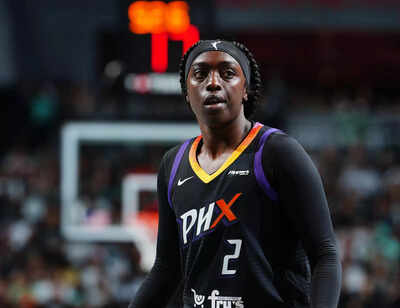The world of professional sports often delivers unexpected moments, but a recent WNBA game between the Washington Mystics and the Phoenix Mercury brought forth an incident so unusual, it has sparked widespread discussion and debate. What started as a routine basketball match quickly devolved into a scene that left many questioning the boundaries of fan interaction, player sensitivity, and the very nature of live sporting events.
During the intense matchup, Phoenix Mercury player Kahleah Copper found herself in an unforeseen predicament. In the heat of the game, her wig, for reasons unclear, detached from her head. The item bounced around the court before eventually going through the rim – a moment that, while initially appearing as a minor, albeit awkward, wardrobe malfunction, rapidly escalated into something far more significant.
To the surprise of many, the game was immediately halted. Officials called a timeout, allowing Copper to address the situation. This decision itself became a point of contention for some observers, who questioned whether such an occurrence warranted a stoppage in play. Critics quickly drew parallels, asking why a game would continue if a player lost a shoe, but come to a complete standstill for a wig. This perceived inconsistency fueled early discussions about the league’s priorities and protocols.
However, the incident took an even more dramatic turn moments later. As the players and officials processed the unusual interruption, attention shifted to the stands. It was then that members of the Phoenix Mercury bench, notably Alyssa Thomas and Nate Tibbetts, reportedly identified a fan to arena security. The accusation? The fan had allegedly laughed and made a joke about Copper’s wig coming off.
What followed was swift and decisive: the fan was ejected from the arena. This action ignited a firestorm of controversy, raising critical questions about freedom of expression for spectators versus the perceived need to protect players from perceived disrespect. Many onlookers found the decision to remove a fan for a laugh or a joke about a visible blooper to be an extreme overreaction. They argued that fans attend games for entertainment, and occasional bloopers are an inherent part of live sports, often eliciting natural, albeit sometimes unsympathetic, reactions.

The incident has since become a flashpoint for broader discussions about the WNBA’s relationship with its fanbase and the atmosphere it cultivates. Critics have voiced concerns that such strict enforcement stifles organic fan engagement and creates an overly sensitive environment. They contend that if every laughter or lighthearted comment about an on-court mishap leads to ejection, it sets a dangerous precedent, potentially alienating the very audience the league aims to attract.
Furthermore, the discussion delved into the optics of players wearing wigs during high-impact sports. While personal style and choice are paramount, some questioned the practicality of wearing a long wig that could easily become dislodged during physical play. This line of questioning was not to shame or criticize, but rather to understand the potential for such incidents and their impact on game flow.

The commentary surrounding the event also touched upon the way the incident was handled by broadcasters. Some noted a perceived reluctance to explicitly describe what had happened, instead using euphemisms or avoiding direct mention of the wig. This avoidance, for some, highlighted an excessive level of self-consciousness or taboo around the topic, further contributing to the surreal nature of the entire event.
In essence, Kahleah Copper’s wig malfunction transformed a regular WNBA game into a viral moment, not for athletic prowess, but for an unforeseen confluence of events: an on-court mishap, an immediate game halt, and the controversial ejection of a fan. It has spurred a wide-ranging conversation about player sensitivity, fan rights, and the evolving dynamics between professional sports leagues and their passionate, sometimes boisterous, audiences. The incident serves as a peculiar case study in the fine line between protecting athletes and preserving the lively, unpredictable nature of live sports entertainment.
